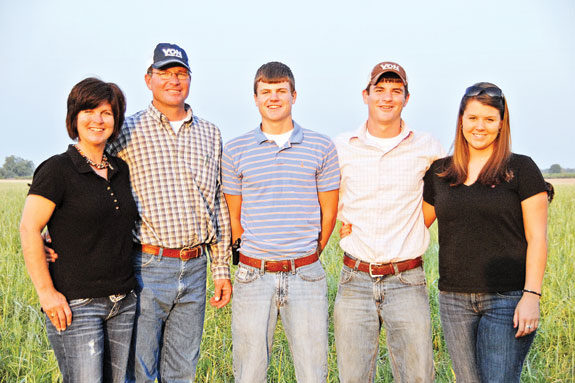“One of the most gratifying things we do is go and open the gate and turn the cattle onto fresh pasture,” says Yon, who runs between 1,300 and 1,400 registered Angus cattle on 2,500 acres.
“We give them nutritious forages that my family and the good Lord have grown.
With a grazing operation we have less inputs. We do have to depend on harvested forages as well, but we try to let the cattle graze as much as they can.
We try to do it with less fuel, steel, pesticides and herbicides. We are trying to minimize our inputs to a point of optimum production.”
As a seedstock operation, Yon Family Farms produces top-quality Angus bulls and cows. Developing youngstock into an animal that will bring top dollar at their semi-annual auctions means providing those animals with the best forages possible.
“Our very best forages go to the animals that need them most,” says Yon, a first-generation Angus breeder in Ridge Spring, South Carolina.
“Whether it’s the developing heifers or the developing bulls or the lactating cows during breeding season, we match cattle nutritional needs to forage quality.”
Where does alfalfa stand?
Although most of the 2,500 acres are primarily bermudagrass, Yon plants small grains, ryegrass, pearl millet, sudangrass and alfalfa to add quality to the diet.
His alfalfa is another way to increase quality without increasing inputs. In 2006, Yon planted AlfaGraze 600 RR, a Genuity® Roundup Ready® variety that was designed to work well for grazing systems in southern climates. Even after five years, this variety is still going strong.
“We were able to take away the weed pressure with a single spraying of Roundup per year, at the most two sprayings per year,” says Yon, who had 12 acres of Alfagraze 600 RR but planted 40 more acres in September 2011.
“It kept back the weed competition and allowed us to get a good stand of alfalfa right off the bat. Spraying it annually or biannually has stopped encroachment of grasses and other weeds.
Actually we have used fewer herbicides with this Roundup Ready® variety than we did with conventional varieties. So it’s meant fewer trips across the field, less input costs.
The initial seed costs were higher but over time we felt like we got a healthier, thicker stand and sprayed it less than we would have with conventional varieties.”
Another input forage growers are familiar with is fertilizer. With the price of oil going up, petroleum-based fertilizers are also increasing in cost. Alfalfa requires less fertilizer than most other forages, which means it saves money at planting and over the long run.
“Our other forage crops have high nitrogen requirements,” says Yon, the 2008 National Environmental Stewardship Award winner.
“The nice thing about the alfalfa is it actually cuts our fertilizer cost per acre. All we have to buy for alfalfa is potash and boron each year. When nitrogen was cheap, we didn’t pay as much attention.
But now that fertilizers are expensive, this forage saves us money because we don’t have to apply nitrogen. The savings on fuel by just grazing it instead of harvesting it, and by making fewer trips over the field applying fertilizer and herbicides, means thicker stands and less inputs.”
With a relatively small section of his acres in alfalfa, management becomes key in not overgrazing this high-quality forage.
Yon has his 12 acres split into six paddocks with temporary electric fencing. He opens the gate and lets his cattle graze a paddock for a few hours at a time.
When the paddock is grazed down to an acceptable height, Yon will rest that paddock for 20 to 25 days.
“We are grazing it down and resting it,” Yon explains. “We aren’t just opening the gate and letting the cows graze it. It’s done in a controlled fashion.
It’s kind of like turning them out to a feedbunk, except we are letting them graze alfalfa for several hours a day and then they are coming off of it.”
Yon saves the alfalfa acres for the animals that need it most. Priority is given to developing heifers and developing bulls – the young growing stock that can really utilize the forage quality.
According to John Andrae, associate professor and forage specialist at Clemson University, Yon does an exceptional job of matching the animal’s nutrient requirements with the type of forages that can meet those needs.
“He does a good job of matching when he needs those high-quality forages and when the cowherd can get by on lower-quality perennials,” says Andrae, who has been teaching pasture management at Georgia and now Clemson for more than 10 years.
“Alfalfa does seem to fit into Kevin’s operation. One thing about Kevin is he understands the value of high-quality forages and he has a need for it with those high-value cattle and purebred bulls.”
Grazing time
When Andrae is asked about when a field should be harvested, he suggests looking at a calendar on the wall before looking at the field.
“They need to see how long the rest period was, because maturity drives everything,” Andrae says. “They can cut by the calendar or harvest by the calendar and know when it’s going to be a young, vegetative forage.
Visually you can look at leaf-to-stem ratio and other indicators of maturity – leaf number, seed heads, blooms and color – and get a feel for the quality of that forage. But, oddly enough, I would say the predominant thing to look at is the calendar.”
Producers should try to keep rest periods relatively short so the field stays in a rapid growth phase but in a vegetative phase. This will give the forage its highest feed value, Andrae says.
Intensive grazing can be stressful on some alfalfa varieties, so choosing a variety that is bred to yield under pressure is important. Get a variety that has high vigor and recovers fast after cutting.
“Some varieties are bred to withstand traffic and come back fast after every cutting,” says Dwight Tuttle, national brand manager for America’s Alfalfa.
“University and demo plots test many varieties, giving producers an accurate idea of how varieties will perform.
Planting seed that may be cheaper but isn’t proven can be risky. For grazing operations, they need a variety that will stand up to the traffic and grow back vigorously.”
Yon and his wife started Yon Family Farm in 1996 and managed another beef grazing operation for eight years before that. With all that experience, Yon says it’s as much an art as it is a science.
“After a while you get a feel for it,” he says. “You know when the forages are at optimum value. I don’t know how to explain it, but that’s where the art comes into it.
Not that I’ve mastered it – we are always trying to learn more. Grazing management is having a feel for, or knowledge of, when to graze.
Knowing when to get off and rest the pasture might be even more important. Being diligent in grazing management is critical for successfully managing lower input costs and nutritional value to meet the needs of our livestock.”
The lower inputs of the Yon Family Farm’s grazing system doesn’t just help their bottom line, it’s a gratifying way to manage the needs of their animals.
With the right forages and a skillful eye on the pasture, Yon Family Farm continues to deliver quality seedstock to their customers. FG
Ryan Curtis is the account executive at Duff Dynamic Marketing for America’s Alfalfa.
PHOTO:
One of the most gratifying things we do is go and open the gate and turn the cattle onto fresh pasture. We give them nutritious forages that my family and the good Lord have grown. Photo courtesy of Yon Family Farm.











